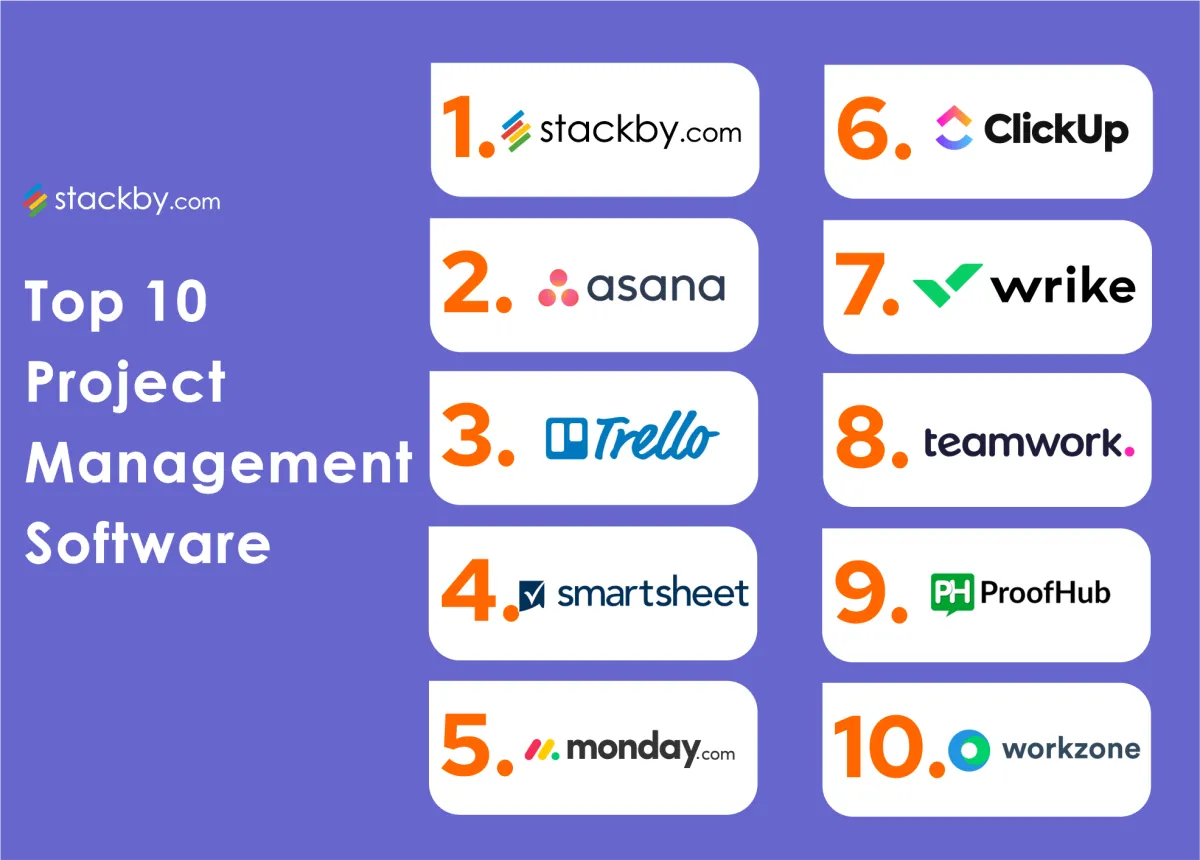Discover the top 10 cutting-edge software solutions that will revolutionize project management efficiency in 2024. From advanced task tracking to interactive collaboration tools, these platforms are set to streamline project workflows and enhance team productivity.
Asana
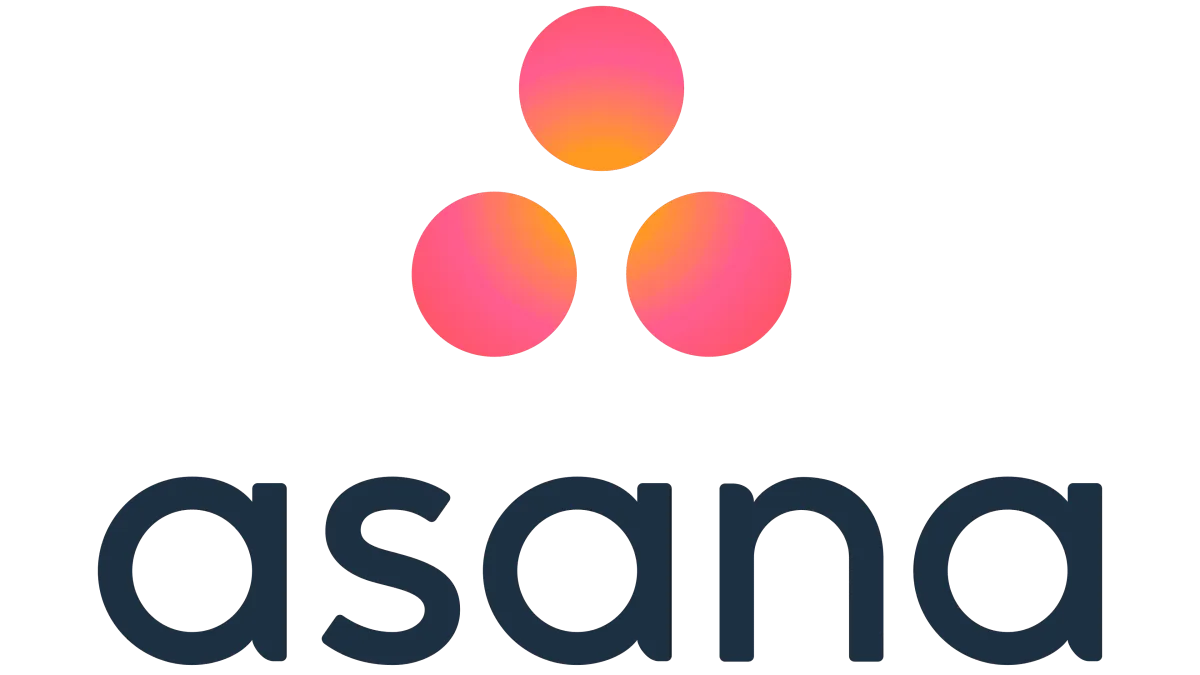
Asana is a popular cloud-based project management software designed to help teams organize, track, and manage their work. Known for its user-friendly interface and robust features, Asana caters to a wide range of teams and project styles.
Key Features:
- Task Management: Create tasks, assign them to team members, set due dates, and add attachments.
- Project Views: Visualize projects in multiple ways, including lists, boards (Kanban), timelines, and calendars.
- Collaboration Tools: Facilitate communication with built-in messaging, comments within tasks, and file sharing.
- Automation: Streamline workflows by automating repetitive tasks, such as assigning tasks and sending notifications.
- Integrations: Connect Asana with other tools you already use, such as Slack, Google Workspace, and Microsoft Teams.
Pros:
- Intuitive and easy to use, even for beginners.
- Offers a free plan for small teams.
- Highly customizable to fit various project needs.
- Strong collaboration features to keep everyone on the same page.
Cons:
- Can become complex for managing very large and intricate projects.
- Limited reporting features in the free plan.
Trello
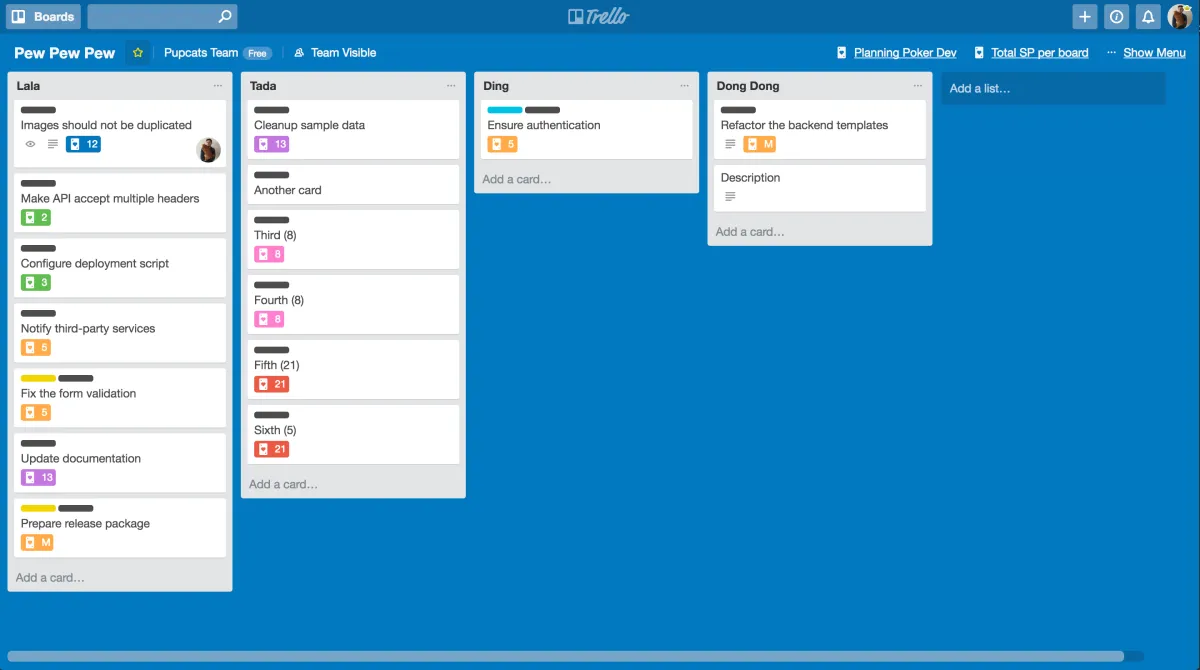
Trello is a popular project management software known for its intuitive visual interface based on the Kanban system. It allows users to create boards for different projects, and within each board, lists are used to represent different stages of a project. Tasks are then added as cards within these lists and can be easily moved between lists as progress is made.
Key features of Trello:
- Kanban boards: Visualize project progress at a glance.
- Cards and lists: Organize tasks, assign team members, and track deadlines.
- Collaboration features: Comment on cards, share files, and mention teammates for seamless communication.
- Power-Ups: Integrate with other popular tools like Google Drive, Slack, and Dropbox.
- Customizable workflows: Adapt Trello to your team’s specific needs and processes.
Trello is an excellent option for teams and individuals who prefer a visual and flexible approach to project management. It is particularly well-suited for managing tasks in areas like marketing, content creation, software development, and more.
Monday.com
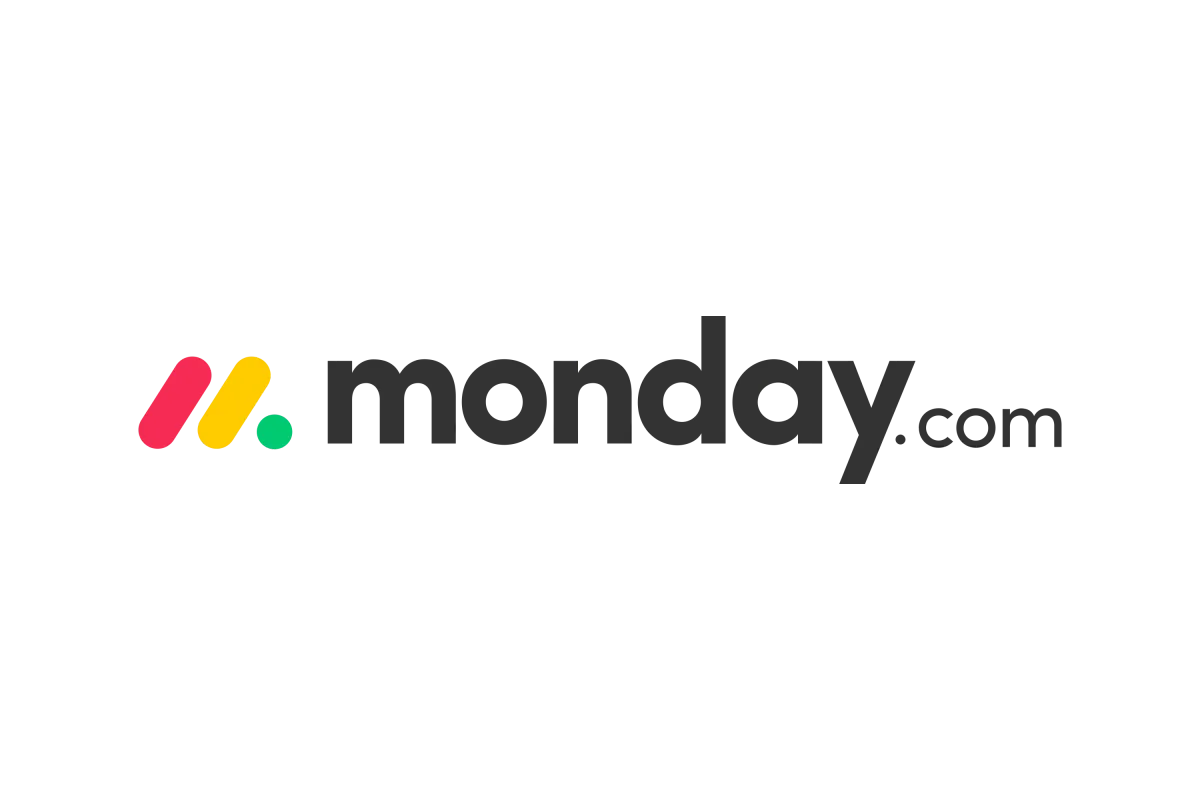
Monday.com stands out as a highly visual and adaptable project management platform catering to teams of all sizes. Its intuitive drag-and-drop interface makes it easy to create and manage tasks, assign responsibilities, and track progress visually.
Key Features:
- Customizable Boards: Tailor boards to different project styles – Kanban, Gantt, calendar, and more.
- Automation: Streamline repetitive tasks and workflows to boost efficiency.
- Collaboration Tools: Real-time chat, file sharing, and commenting keep teams connected.
- Integrations: Connect with popular tools like Slack, Google Drive, and Microsoft Teams.
- Reporting and Analytics: Gain insights into project health, team performance, and identify bottlenecks.
Monday.com’s flexibility and visual appeal make it suitable for diverse project needs, from marketing campaigns to software development. Its user-friendly nature encourages team adoption and collaboration.
ClickUp

ClickUp has rapidly gained popularity as an all-in-one project management solution known for its robust features and customization options.
Key Features:
- Task management with custom fields, subtasks, and dependencies.
- Multiple views, including list, board (Kanban), Gantt chart, and calendar.
- Collaboration tools like real-time chat, document editing, and comments.
- Automations for streamlining repetitive tasks and workflows.
- Goal setting and progress tracking features.
- Time tracking and reporting capabilities.
- Integrations with a wide range of third-party apps.
Pros:
- Highly customizable to fit various team workflows and project needs.
- Offers a comprehensive set of features, minimizing the need for multiple tools.
- User-friendly interface with drag-and-drop functionality.
- Free plan available with generous features for small teams.
Cons:
- The extensive customization options can be overwhelming for some users.
- Some advanced features might require a learning curve.
Best for: Teams of all sizes looking for a highly customizable and feature-rich project management solution with a free plan option. Its versatility makes it suitable for various industries and project types.
Basecamp
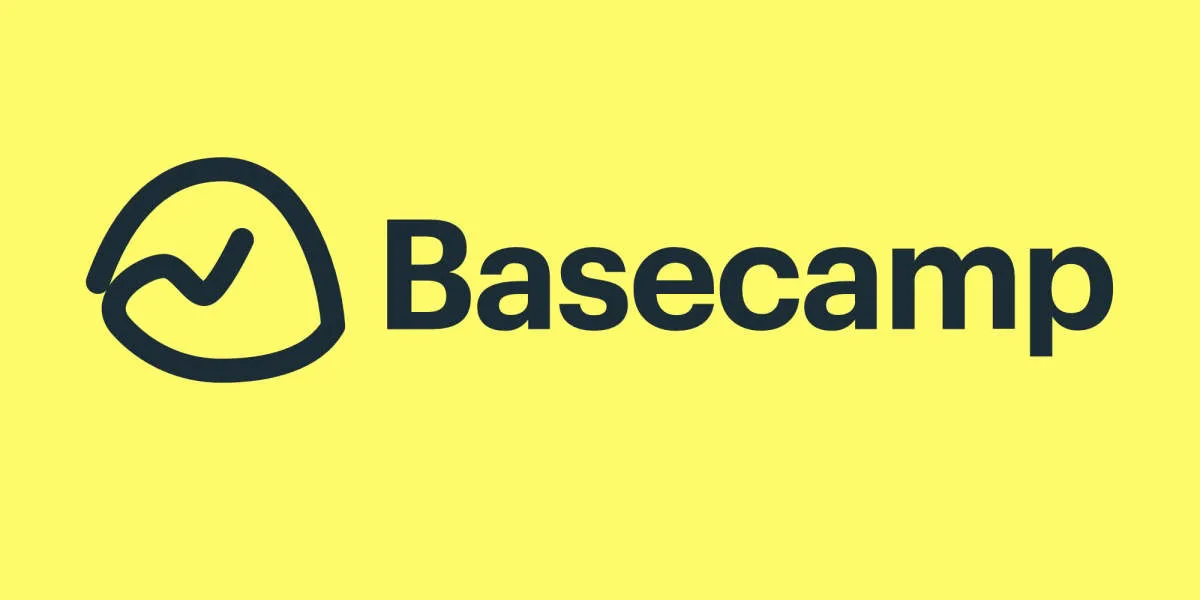
Basecamp is a well-established project management solution known for its simplicity and focus on team communication. It aims to streamline project collaboration by providing a centralized platform for task management, file sharing, and discussions.
Key Features of Basecamp:
- Centralized message board: Facilitates team communication and keeps everyone informed.
- To-do lists: Allows for clear task assignment and progress tracking.
- Schedule management: Enables scheduling of deadlines and milestones, providing a shared team calendar.
- File sharing and document collaboration: Provides a central hub for storing and collaborating on project documents.
- Client access: Allows for controlled project visibility and communication with clients.
Pros of Basecamp:
- User-friendly interface, making it easy to adopt for teams of all technical skills.
- Strong emphasis on communication, promoting transparency and collaboration.
- Flat pricing model, making it a predictable cost for teams.
Cons of Basecamp:
- Limited customization options compared to some other project management tools.
- May lack advanced features required for complex project workflows.
Basecamp is a suitable option for teams seeking a straightforward platform that prioritizes communication and basic task management. It’s particularly well-suited for smaller businesses or teams working on projects with relatively simple workflows.
## Jira
Jira, developed by Atlassian, is a highly popular project management tool known for its robust features and versatility. It is widely used across various industries and team sizes, particularly favored by software development teams using Agile methodologies.
Key Features of Jira:
- Agile Project Management: Jira excels in supporting Scrum and Kanban methodologies with features like sprint planning, backlog management, and customizable workflows.
- Issue Tracking: Teams can effectively track bugs, tasks, and user stories. Issues can be prioritized, assigned, and tracked throughout their lifecycle.
- Collaboration: Jira facilitates seamless team communication with features like comments, @mentions, and real-time updates on issue progress.
- Customizable Dashboards and Reports: Users can create personalized dashboards and generate insightful reports to visualize project progress and identify potential bottlenecks.
- Extensive Integrations: Jira integrates seamlessly with a vast array of tools, including development tools, communication platforms, and other project management software.
Why Choose Jira?
Jira’s comprehensive feature set, flexibility, and scalability make it an ideal choice for teams seeking a powerful solution to manage complex projects. Its adaptability to various workflows and industries solidifies its position as a leading project management software.
Wrike
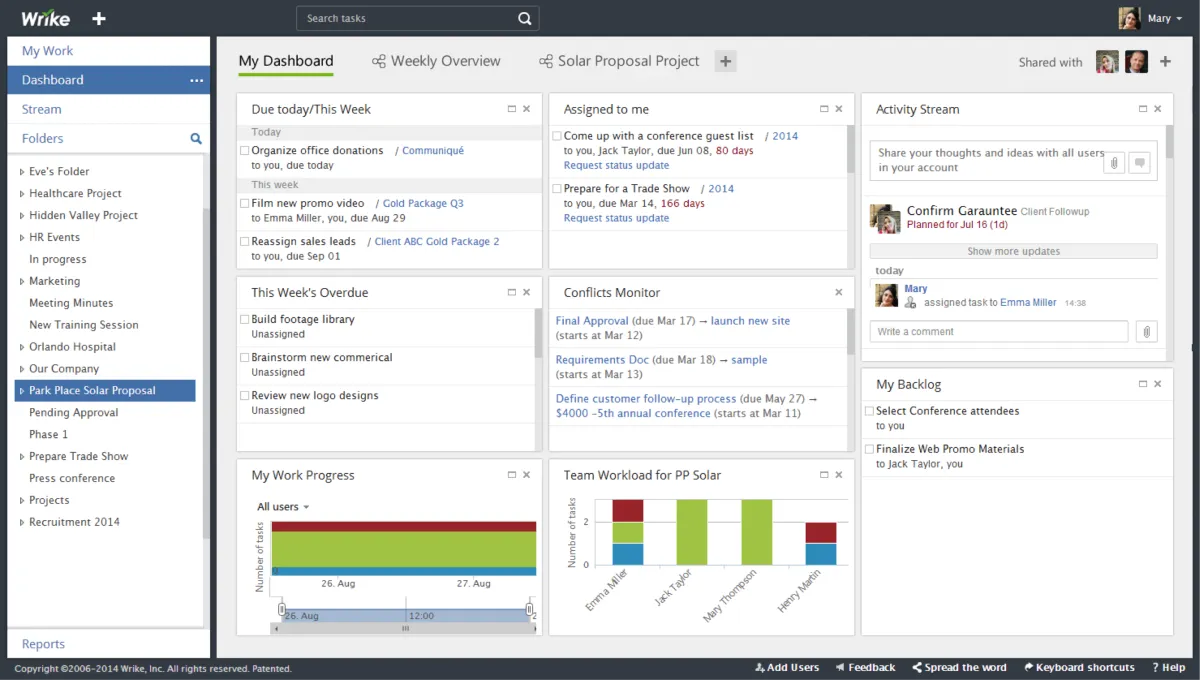
Wrike is a robust project management software solution that caters to a wide range of teams and organizations. It boasts an intuitive interface with a plethora of features designed to streamline workflows and boost productivity.
Key Features of Wrike:
- Task Management: Create, assign, and prioritize tasks with ease. Set deadlines, add dependencies, and track progress visually with Gantt charts.
- Collaboration Tools: Communicate seamlessly with your team members directly within tasks, share files, and receive real-time notifications.
- Workflow Automation: Automate repetitive tasks and approvals to save time and minimize errors.
- Reporting and Analytics: Gain valuable insights into project performance with customizable dashboards and reports. Track key metrics and identify areas for improvement.
- Integrations: Connect Wrike with your favorite apps and tools, such as Slack, Google Drive, and Microsoft Teams, for a centralized workflow.
Benefits of using Wrike:
- Improved team collaboration and communication.
- Enhanced project visibility and control.
- Increased efficiency and productivity.
- Reduced risk of project delays and bottlenecks.
- Data-driven decision-making.
Wrike offers a variety of plans to fit different needs and budgets, including a free plan for small teams.
Smartsheet
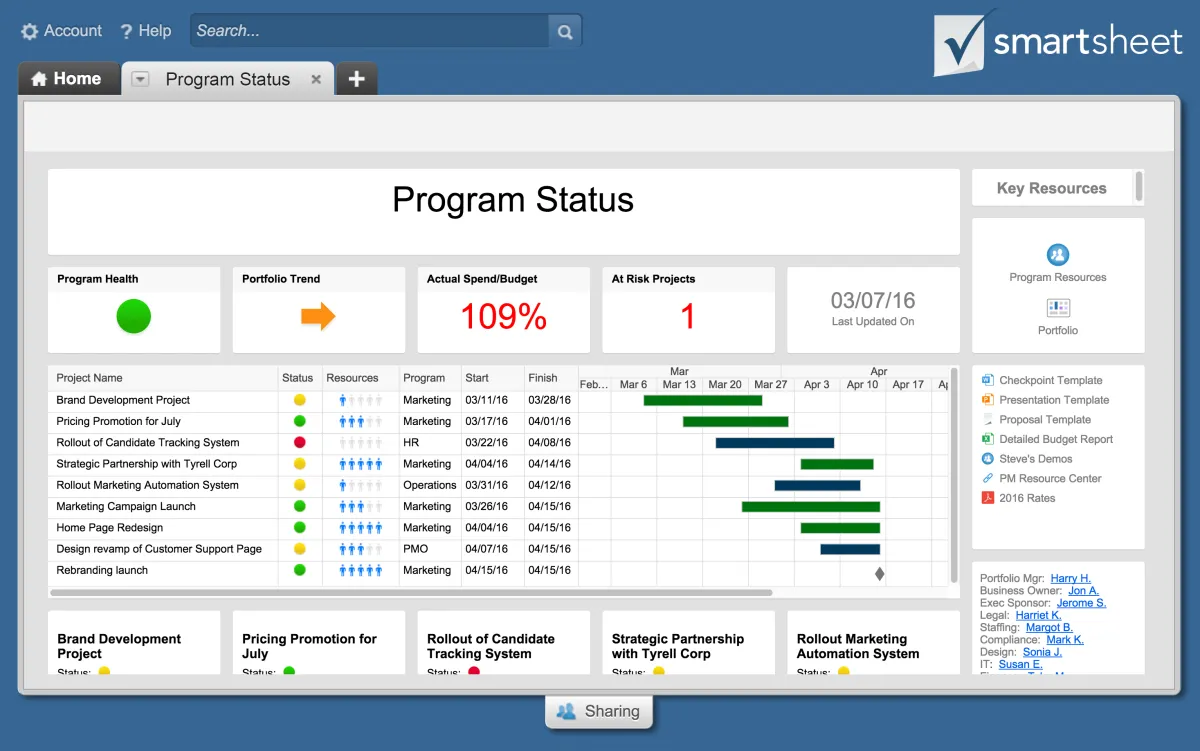
Smartsheet is a cloud-based work management and collaboration platform that offers a robust suite of tools for efficient project management. Its intuitive spreadsheet-like interface makes it easy for teams to plan, track, automate, and report on projects of all sizes.
Key Features:
- Flexible Views: Visualize project data in various formats, including grids, Gantt charts, Kanban boards, and calendars, to suit different needs and preferences.
- Collaboration Tools: Facilitate seamless teamwork with features like real-time co-editing, file sharing, task assignments, and built-in communication channels.
- Automation Capabilities: Streamline workflows and reduce manual effort by automating repetitive tasks, notifications, and approvals.
- Resource Management: Optimize resource allocation with insights into team availability, workload, and capacity planning.
- Reporting and Analytics: Generate comprehensive reports and dashboards to track project progress, identify bottlenecks, and make data-driven decisions.
Benefits for Project Management:
Smartsheet empowers project managers and teams to:
- Improve project planning and scheduling accuracy.
- Enhance team collaboration and communication.
- Boost productivity by automating tasks and workflows.
- Gain real-time visibility into project status and performance.
- Make informed decisions based on data-driven insights.
Microsoft Project
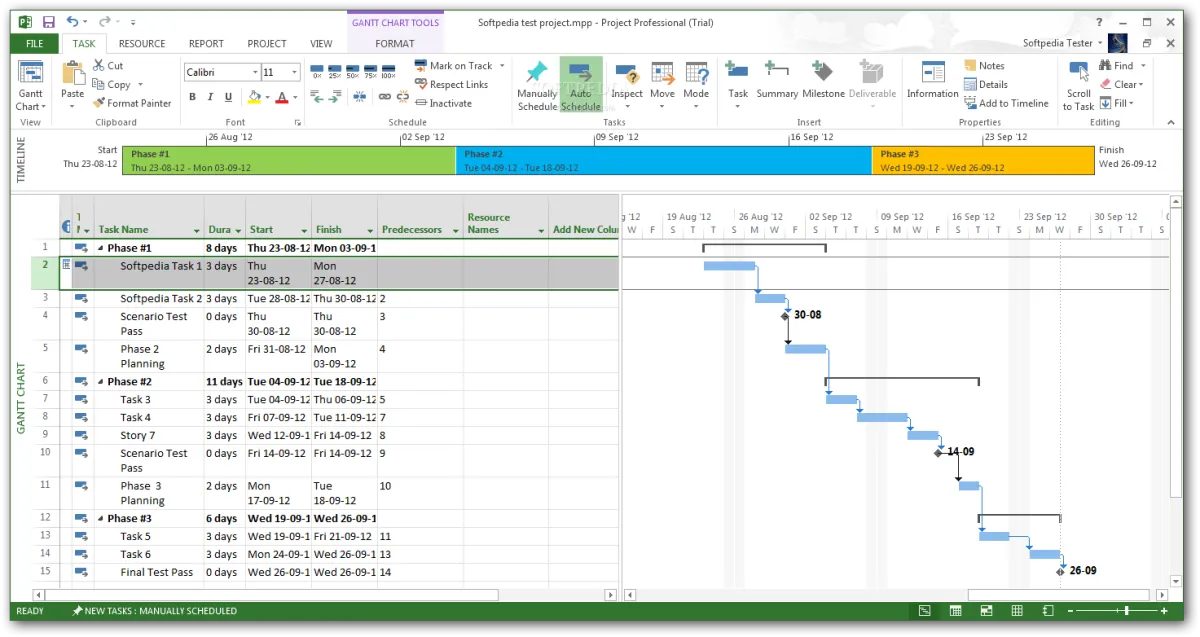
A veteran in the project management software arena, Microsoft Project remains a robust and popular choice, particularly for larger organizations or those heavily invested in the Microsoft ecosystem.
Key Features:
- Gantt chart visualization: Plan and visualize project timelines effortlessly with interactive Gantt charts.
- Resource management: Assign tasks, track workloads, and optimize resource allocation to avoid bottlenecks.
- Collaboration tools: Communicate within the platform, share files, and keep everyone updated on project progress.
- Reporting and analytics: Generate detailed reports to monitor key metrics, identify risks, and make informed decisions.
- Integration with other Microsoft products: Seamlessly connect with tools like Microsoft Teams, SharePoint, and Power BI for a unified workflow.
Pros:
- Powerful and feature-rich, suitable for complex projects
- Widely used, leading to a large talent pool and readily available support
- Excellent integration within the Microsoft ecosystem
Cons:
- Can be expensive, especially for smaller teams
- Steeper learning curve compared to some more user-friendly options
Teamwork

At the heart of successful project management lies seamless teamwork. The ability for team members to collaborate effectively, share knowledge, and stay updated on progress is crucial. Thankfully, many software solutions recognize this and offer features explicitly designed to enhance teamwork.
Here’s what to look for in project management software in terms of teamwork:
- Communication Tools: Built-in instant messaging, discussion forums, and even video conferencing capabilities can streamline communication and reduce the need for external tools.
- Task Assignment and Tracking: Clear assignment features ensure everyone knows their responsibilities. Real-time tracking provides transparency on individual progress, allowing for timely support or adjustments.
- File Sharing and Version Control: A centralized platform for sharing documents, spreadsheets, and other files eliminates confusion and ensures everyone is working with the most up-to-date versions.
- Feedback Mechanisms: Features that allow for easy feedback on tasks, documents, or project stages can significantly improve collaboration and quality of work.
- Shared Workspaces: Dedicated project spaces within the software provide a central hub where teams can access relevant information, track progress, and collaborate efficiently.
By prioritizing these teamwork-focused features, project management software becomes more than just a tool for managing deadlines; it becomes a platform for fostering a collaborative and productive work environment.
Conclusion
Choosing the right software for project management is crucial in maximizing productivity and efficiency. The top 10 software solutions highlighted for 2024 offer diverse features to cater to various project needs, making them essential tools for successful project execution.

